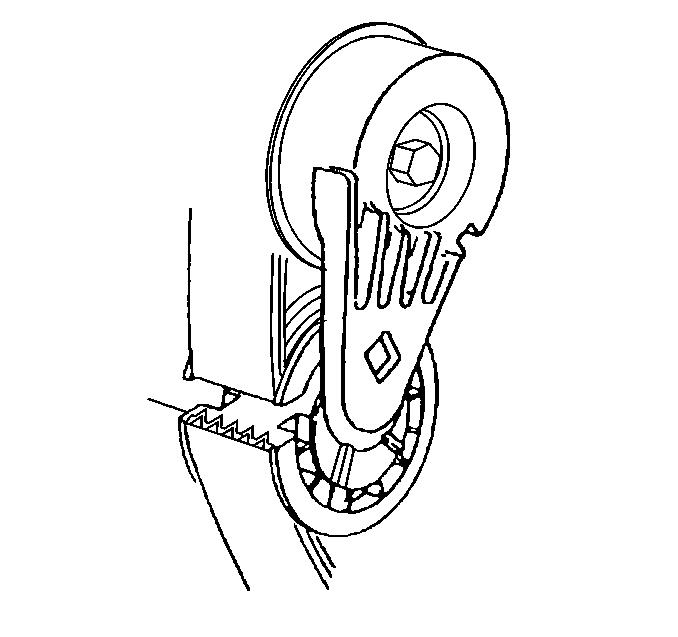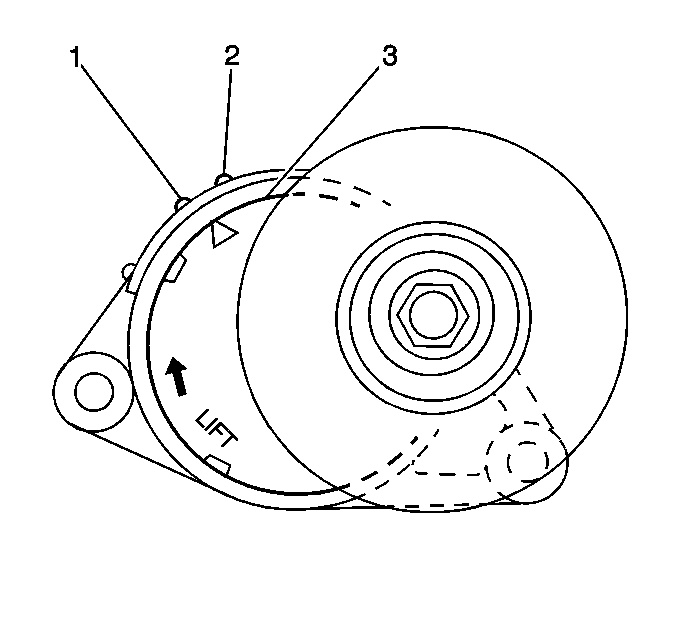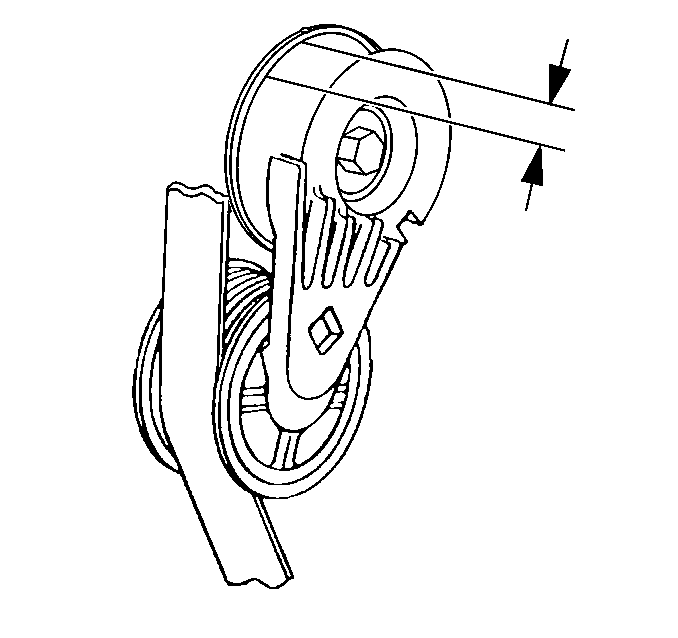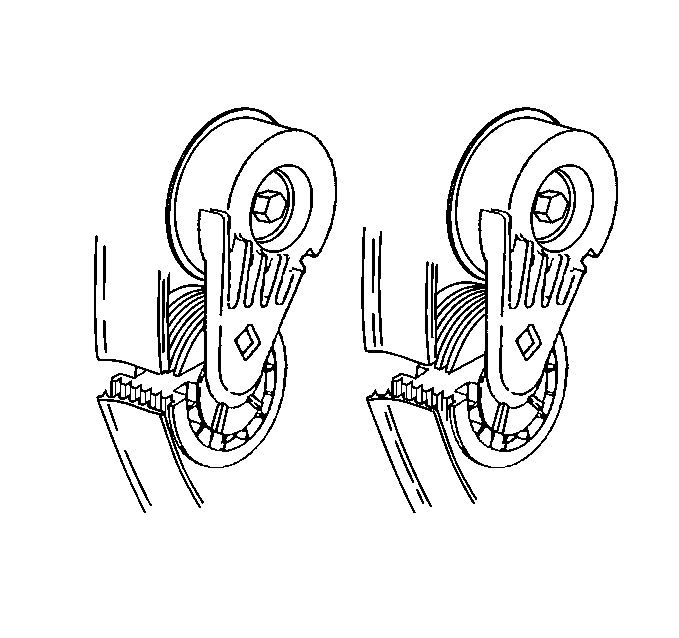| Table 1: | Chirping |
| Table 2: | Squeal |
| Table 3: | Whine |
| Table 4: | Faint Cycle Rumbling |
| Table 5: | Drive Belt Vibration |
| Table 6: | Drive Belt Falls Off |
| Table 7: | Excessive Wear in Either Outside Groove of Drive Belt |
Drive Belt Noise
Drive belt noise may be described as a thumping noise heard at, or just above idle speed, as a result of drive belt pilling. Drive belt pilling occurs when small particles of drive belt material separate from the drive belt grooves, and form small balls or pills in the drive belt grooves. While some drive belt piling is normal, excessive pilling can cause a thump or knocking as the pills pass over various drive belt pulleys. This causes the drive belt to repeatedly jump off of and slap onto the drive belt pulley.
The thump or knocking noise easily misdiagnosed as an engine noise. In order to diagnosis drive belt pilling, adhere to the following procedure:
- Remove the drive belt.
- Run the engine for no more than 30 to 40 seconds, in order to confirm that the engine noise disappears.
- Inspect the power steering pulley for proper alignment.
- Inspect all other pulleys for excess paint, debris or pills in the grooves.
- Clean the pulleys with a wire brush, as necessary.
Step | Action | Value(s) | Yes | No |
|---|---|---|---|---|
DEFINITION: A high pitched noise usually heard once per revolution of a pulley or belt. It is usually heard at idle and is most common on cold damp mornings. Squirting water on a chirping belt will usually cause the noise to momentarily go away. | ||||
1 | Check for misalignment of the pulleys. Are any of the pulleys misaligned? | -- | ||
2 | Replace any misaligned pulleys. Is the chirp still present? | -- | System OK | |
3 | Check for bent or cracked brackets. Are there any bent or cracked brackets? | -- | ||
4 | Replace any bent or cracked brackets. Is the chirp still present? | -- | System OK | |
5 | Check for any loose or missing fasteners. Are there any loose or missing fasteners? | -- | ||
6 | Tighten any loose fasteners and properly install any missing fasteners. Refer to Fastener Tightening Specifications . Is the chirp still present? | -- | System OK | |
7 | Check for a bent pulley flange. Is the pulley flange bent? | -- | ||
8 | Replace the pulley flange. Is the chirp still present? | -- | System OK | |
9 | Check for severe pilling, exceeding 1/3 of the belt groove depth. Is there severe pilling? | -- | -- | |
10 | Replace the drive belt. Refer to Drive Belt Replacement . Is the chirp still present? | -- | -- | System OK |
Step | Action | Value(s) | Yes | No |
|---|---|---|---|---|
DEFINITION: A loud screeching noise that is caused by a slipping belt (this is unusual for a belt with multiple ribs). The noise occurs when a heavy load is applied to the belt, such as an air conditioning compressor engagement, snapping the throttle, or slipping on a seized pulley. | ||||
1 | Check for a misaligned pulley. Is there a misaligned pulley? | -- | ||
2 | Check for incorrect belt length, refer to Drive Belt Diagnosis . Is the belt length correct? | -- | ||
3 | Repair or install new parts as necessary. Is the repair complete? | -- | System OK | -- |
4 | Check for a malfunctioning drive belt tensioner, refer to Drive Belt Tensioner Diagnosis . Is the tensioner malfunctioning? | -- | ||
5 | Check for correct pulley size. Are the pulleys the correct size? | -- | ||
6 | Check for seized bearings. Is there a seized bearing? | -- | System OK | |
Step | Action | Value(s) | Yes | No |
|---|---|---|---|---|
DEFINITION: A high pitched continuous noise that may be caused by a failed bearing. | ||||
1 | Check for a worn accessory component bearing. Is a bearing making the noise? | -- | System OK | |
2 | Install new parts as necessary. Is the repair complete? | -- | System OK | -- |
Step | Action | Value(s) | Yes | No |
|---|---|---|---|---|
DEFINITION: A low frequency noise heard once per revolution of the drive belt. | ||||
1 | Check for severe pilling. Is there severe pilling of more than 1/3 of the rib depth? | -- | Go to Step 2 | System OK |
2 | Clean the drive belt pulleys. Are the drive belt pulleys clean? | -- | Go to Step 3 | -- |
Step | Action | Value(s) | Yes | No |
|---|---|---|---|---|
1 | Check for loose or missing fasteners. Are there loose or missing fasteners? | -- | ||
2 | Re-tighten or replace as necessary. Refer to Fastener Tightening Specifications . Is the repair complete? | -- | System OK | -- |
3 | Check for damaged fan blades. Are there damaged fan blades? | -- | ||
4 | Replace as necessary. Refer to Engine Cooling Fan Replacement in Engine Cooling. Is the replacement complete? | -- | System OK | -- |
5 | Check for a bent fan clutch or coolant pump shaft. Is the fan clutch or coolant pump shaft bent? | -- | ||
6 | Replace as necessary. Refer to Water Pump Replacement in Engine Cooling. Is the repair complete? | -- | System OK | -- |
7 | Check for bent or cracked brackets. Are there bent or cracked brackets? | -- | System OK | |
8 | Replace the brackets as necessary. Is the repair complete? | -- | System OK | -- |
Step | Action | Value(s) | Yes | No |
|---|---|---|---|---|
1 | Check for a misaligned or a bent pulley. Are the pulleys misaligned? | -- | ||
2 | Replace any misaligned or bent pulleys. Does the drive belt continue to fall off? | -- | System OK | |
3 | Check for a bent or a cracked bracket. Are any of the brackets bent or cracked? | -- | ||
4 | Replace the damaged brackets. Does the drive belt continue to fall off? | -- | System OK | |
5 | Check for loose or missing fasteners. Are there any loose or missing fasteners? | -- | ||
6 | Replace any missing fasteners and tighten to specifications. Refer to Fastener Tightening Specifications . Does the drive belt continue to fall off? | -- | System OK | |
7 | Check for a misaligned power steering pump pulley. Is the power steering pump pulley misaligned? | -- | ||
8 | Realign or replace the power steering pump pulley. Refer to Power Steering Pump Pulley Replacement in Power Steering System. Does the drive belt continue to fall off? | -- | System OK | |
9 | Check for a damaged drive belt. Is the drive belt damaged? | -- | ||
10 | Replace the drive belt. Refer to Drive Belt Replacement . Does the drive belt continue to fall off? | -- | System OK | |
11 | Check for a malfunctioning drive belt tensioner. Is the drive belt tensioner malfunctioning? | -- | ||
12 | Replace the drive belt tensioner. Refer to Drive Belt Tensioner Replacement . Does the drive belt continue to fall off? | -- | System OK | |
13 | Check for worn idler pulley bearings. Are the idler pulley bearings worn? | -- | -- | |
14 | Replace the idler pulley. Refer to Drive Belt Idler Pulley Replacement . Does the drive belt continue to fall off? | -- | -- | System OK |
Step | Action | Value(s) | Yes | No |
|---|---|---|---|---|
1 | Check to see if the ribs in the drive belt do not match the grooves in the pulley. Do the ribs in the drive belt match the grooves in the pulley? | -- | -- | |
2 | Replace the drive belt. Refer to Drive Belt Replacement . Is there still excessive wear in either outside groove of the drive belt? | -- | -- | System OK |
General Instructions
The following graphics illustrate the correct way to route the drive belt over the pulleys, and some examples of incorrect belt placement.
- Observe the drive belt correctly installed on the pulley.
- When installing a new drive belt, observe the indicator (3) on the tensioner.
- When installing a used drive belt, observe the indicator on the tensioner.
- Observe these incorrectly installed drive belts:

Each groove on the drive belt rests inside a matching groove on the pulley.

A new drive belt should fall inside the minimum (1) and maximum (2) range.

A used drive belt should also fall inside this range.

Avoid mis-positioning the belt by one or more grooves.
